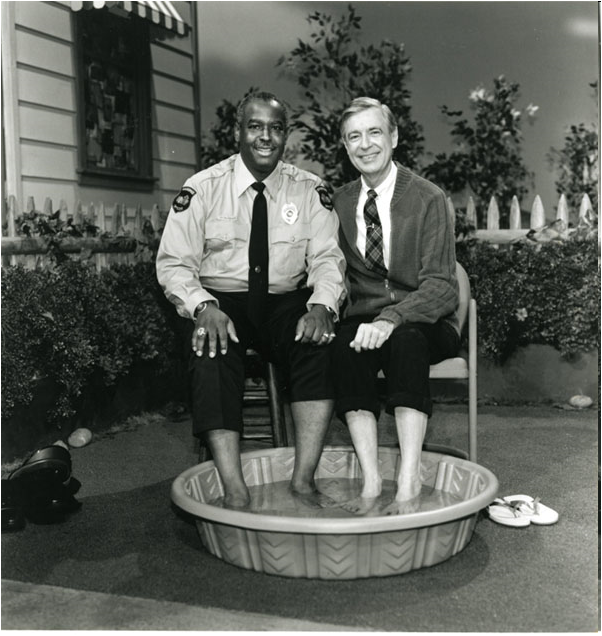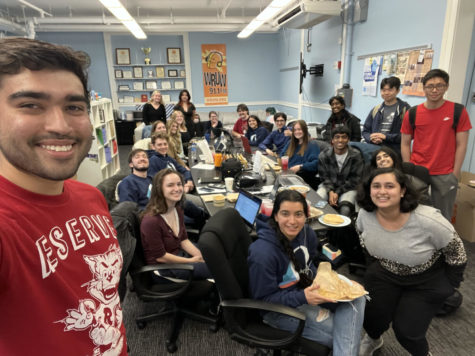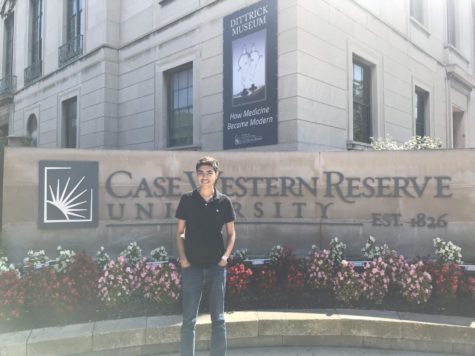Editor’s Note: Mr. Rogers and the virtue of wasting time
Mr. Rogers has seen a resurgence in popularity in recent years, culminating in Tom Hanks’ Oscar-nominated performance in “A Beautiful Day in the Neighborhood.”
January 23, 2020
Mr. Rogers has enjoyed a cultural resurgence in recent years. Tom Hanks’ turn at donning the red sweater and giving life to the children’s show host’s “Land of Make Believe” earned him an Oscar nomination. Rogers has the reputation of a secular saint, the rare star who is exactly as he appeared on T.V., no demons ready to tear someone’s throat out once the camera stops rolling.
Rogers pop culture popularity is not coming from his original target audience of children, as his show went off the air in 2001. Many of his fans are adults who grew up with Rogers and appreciate Hanks’ performance in “A Beautiful Day in The Neighborhood” on a sentimental level, as it brings them back to their childhood. However, many students at Case Western Reserve University did not grow up with Rogers, yet his kind demeanor and calmness still resonate with many people on campus.
The one condition Joanne Rogers had for the filmmakers was that they don’t treat her husband like a saint. Imagining that Rogers had some supernaturally endowed ability to be kind ignores how much theory and planning went into creating The Neighborhood. Rogers, an ordained minister, had a degree in child development and consulted psychologist Margaret McFarland on almost all of his programs. If Rogers simply had otherworldly empathy, it implies that we, as mere mortals, cannot live up to his example. When in reality, though Rogers created something exceptional, he was a normal man like any other, meaning any of us have the ability to create our own beautiful neighborhood.
As a child I did not enjoy Mr. Rogers, it was too quiet for me and I preferred the more high energy programs that Rogers worked to fight against. I preferred the slapstick of Tom and Jerry to relaxed tones. Yet, as an adult, though I don’t sit down to watch Mr. Rogers in times of stress, (that’s what cooking videos are for) I have come to appreciate that message of emotional well-being. I watched “A Beautiful Day in The Neighborhood” with my parents over winter break and loved it. I had read the article that inspired the piece for a feature writing class, so I knew what parts were Hollywood fabrication, but the film’s message, that Rogers was the same man on set as he was off, and that he was still a flawed human stayed true to Junod’s original article.
In “On Becoming Neighbors,” Johns Hopkins professor Alexandra C. Klarén argues that the time Rogers spends to establish ties between Rogers, the characters on the show and the viewer is key to creating a sense of community. Rogers emulates a dialogue on the show, presenting questions to the audience creating the feeling in the viewer that he is speaking directly to them.
Rogers made a point on his show to describe the process behind household objects like crayons or pianos. Rogers showing the human face behind faceless department store goods is an attempt to connect the objects to the viewers, by showing how they can use the object for creative expression but also connecting the object to the people who created it.
“For Rogers, arts and crafts,” writes Klarén. “The act of creating, manipulating and transforming objects using one’s body is what makes for healthy living.”
Rogers places an emphasis on practice, that to live well one must learn through experiencing different things, either exploring the self through one’s emotions, creativity through physical objects or through conversations with others. In the hyper-competitive capitalist United States, there is constant pressure to make every one of our tasks increase our utility in the market. Our friends must also serve as job networks, our hobbies insidiously transform into side hustles. There is constant pressure not to waste time on things that could be better spent doing something productive. The strongest friendships are often built on wasted time, not productive moments. It is the hours spent talking about absurd nonsense. After I cooked a cheesecake, myself and two of my closest friends at CWRU spent an hour going over what it would be like if the walls and floor of the apartment were completely made of that delicious mix of sugar and dairy fat. Should I have been working on this Editor’s Note instead? Definitely. But, I then hesitate and think to a passage in “Becoming Neighbors” where Klarén discusses the source of Mr. Rogers’s favorite quote, “The Little Prince.”
In the French novel, our titular character slowly befriends a fox by “taming” him. This gradual process is done through incremental steps that show care and trust. The prince spends much of the time simply being there silently keeping the fox company. The fox teaches the prince that “establishing ties,” can only be done through sustained acts of care, relating the lesson to a rose plant the boy loved, before saying the words that Mr. Rogers guided much of his philosophy on.
“It is only with the heart that one can see rightly; what is essential is invisible to the eye. It is the time you wasted for your rose that makes your rose so important.















